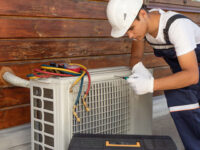Homeowners Insurance – What You Need to Know
Insurance that pays for damages to your home and its contents after a covered peril, subject to the policy’s limits. It also provides liability coverage for damage to others actually or alleged to be caused by the policyholder. Visit https://www.nicholsoninsurance.com for more information.
Property insurance reimburses the owner or renter of a structure and its contents in case they suffer damage or theft. Most home policies protect against a wide range of perils, including fire and lightning, wind and hail damage, explosions, vandalism, theft, damage from vehicles and aircraft, building collapse, earthquakes, and the weight of ice or snow. Policyholders can select from different levels of coverage depending on their preferences, financial situation, and the amount of risk they are willing to accept.
Homeowners insurance usually provides property coverage in three parts that are distinguished by letters: Coverage A for the dwelling, coverage B for other structures and coverage C for personal belongings. A fourth type of coverage, often called coverage D, compensates you for additional living expenses incurred while your home is being repaired or rebuilt following a covered loss. Most property coverage has a deductible that the insured pays out of pocket before the insurer starts paying on a claim.
The dwelling coverage portion of a homeowners policy is usually capped at the maximum amount specified in the policy, such as $300,000 for a single-family residence. Other structures such as a shed, detached garage or gazebo are typically covered at a percentage of the overall dwelling coverage limit, which should be sufficient to rebuild those structures in the event of a loss. Some people opt to increase the dwelling coverage by purchasing an additional endorsement that is known as a rider.
Other riders include flood insurance, which is available separately from home owners’ insurance or can be added to a standard policy; and sewer backup of coverage, which protects the insured in the event of a water or sewage leakage. These types of coverages are not required by law to be included in a home insurance policy.
Other factors that affect the property insurance coverage offered by most companies include the condition of the structure, the distance to the nearest fire department and hydrant, whether the house has smoke detectors and burglar alarms installed, and other safety-related features. Applicants are also screened for the presence of certain hazards, such as pools, trampolines and aggressive dogs on the property.
Liability Coverage
Liability coverage is a part of most insurance policies that protect assets such as homes, automobiles and watercraft. It covers acts of negligence that create a legal obligation to third parties. It can include property damage liability, bodily injury liability and excess medical payments. Most states have laws requiring certain vehicles to carry automobile liability insurance.
A typical home insurance policy provides liability coverage up to the limits stated in the policy. It also generally includes family members who live at home as well as visitors to the residence. However, it doesn’t cover the medical bills of people who are injured while at your house – those are covered by health insurance. Nor does it protect you if someone is injured by your dog — that’s why it makes sense to get a separate animal liability policy.
This article is for information purposes only and does not take into account your personal objectives, financial situation or needs. It should not be considered a substitute for professional advice. Chubb does not advise on the suitability of any particular investment or insurance product. You should obtain a copy of the relevant insurance policy wording and read it to ensure that you understand the terms, conditions and exclusions of the cover.
Additional Living Expenses
If a fire ravages your home or a hurricane ruins the roof, you may have to move out while the property is repaired. Generally, homeowners, condo and renters insurance include additional living expense coverage—also known as loss-of-use coverage—to help pay your costs while you’re not at home.
Depending on your policy, this may cover things like increased hotel bills, rental home costs and more. Some policies also reimburse you for restaurant meals and other expenses that exceed what you would normally spend on these items.
However, ALE coverage isn’t intended to replace your entire income. It covers the costs of a temporary living situation, not your mortgage or other regular expenses you wouldn’t have had to pay if your house weren’t uninhabitable.
Typically, the limit for this type of coverage is 20 % to 30 % of your dwelling insurance limits. This isn’t a fixed amount, so you should discuss the limits and options for this coverage with your agent to determine what’s best for you.
Insurers typically work with companies that specialize in helping their customers find comparable rental homes. They start by looking at homes available on the market and then scouring local real estate listings to find places that meet their policyholders’ needs. Usually, insurers want to find a home that is as close to your normal lifestyle as possible, so they’ll provide a list of available options and let you choose.
The key to maximizing the benefits of this coverage is keeping detailed records and receipts for your expenses. Then, you can submit a claim to be reimbursed.
Remember, you should continue making your mortgage payments and real estate taxes while away from home. Those aren’t covered by additional living expenses, but you can still make them while living in a hotel or rental home. You can also continue to make other monthly bills, such as utilities.
The most important thing to understand is that only certain types of losses qualify for additional living expense reimbursements. For example, if a tree falls on your house and damages one of your bedrooms, it may qualify as a displaced loss. But, if the damage is minor, such as a water leak, it’s unlikely that you’ll be reimbursed for extra living expenses.
Unattached Structures Coverage
Homeowners insurance policies typically include another section called “Coverage B” or “Other Structures Coverage,” which is meant to protect structures that aren’t attached to your home from damage. This coverage is unique to homeowners insurance and not provided by condo or renters insurance. The types of structures that can be covered under this policy vary, but commonly include sheds, fences and detached garages. The coverage is generally equal to 10 percent of your dwelling’s limit, also known as your Coverage A.
In most cases, the automatic Other Structures coverage will be enough to provide adequate protection for your structures. But in some situations, especially when you have high-value detached structures on your property, this may not be the case. If you have a deluxe shed that has a sleeping loft and bathroom, for example, or an expensive in-ground pool, we may need to increase the Other Structures coverage limit on your policy.
Another thing to note about Other Structures coverage is that it typically only covers the structures from perils that can impact your home, including fire and wind. However, it will not provide protection against floods, earthquakes or volcanic eruptions, which are covered under separate policies.
The final thing to consider is that your other structures coverage will either reimburse you for the actual cash value of your structure, or the replacement cost value of your structure. ACV takes depreciation and general wear into account, while RCV will reimburse you for the amount it would take to rebuild or replace the damaged structure. It’s a good idea to opt for the higher replacement value coverage if possible.
One thing to keep in mind is that other structures’ coverage does not typically protect detached structures on your property that are used for business purposes. If you have a shed or detached garage that is used to store tools and equipment for your landscaping company, for example, it will need to be protected by a separate home-based business insurance policy.






